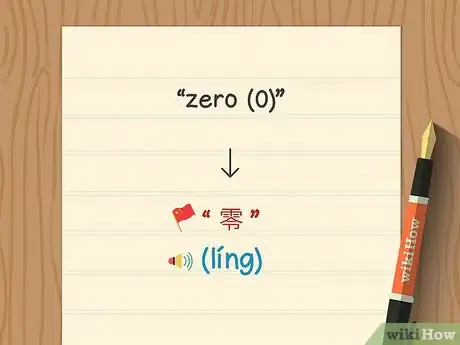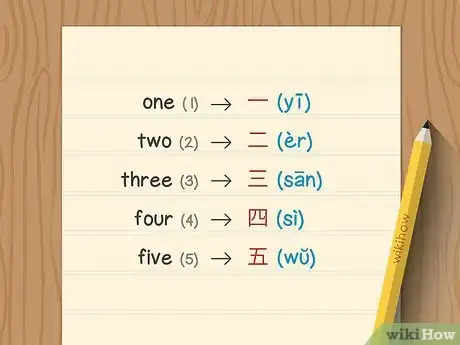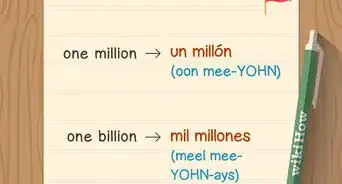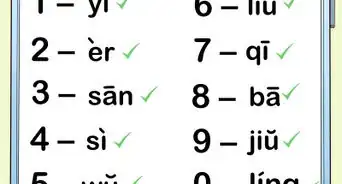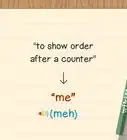This article was co-authored by wikiHow staff writer, Jennifer Mueller, JD, and Godspeed Chen, a trusted member of wikiHow's volunteer community. Godspeed Chen is a Professional Translator from China. He has been working in translation and localization for over 15 years.
wikiHow marks an article as reader-approved once it receives enough positive feedback. In this case, 95% of readers who voted found the article helpful, earning it our reader-approved status.
This article has been viewed 261,344 times.
Learn more...
When most people mention learning Chinese, they're talking about Mandarin Chinese. This dialect is the most widely spoken language in the world, spoken by a billion people in China and another 1.2 billion around the globe.[1] If you want to learn a little Chinese, counting to 10 is a good place to start. And since larger Chinese numbers are formed simply by combining the words for the two digits, if you can count to 10, you can actually count all the way to 99.[2]
Steps
Counting to 10 in Mandarin Chinese
-
1Start with the character for zero (0). 零 is the character for zero (0) and is pronounced líng. Note the tone marker for the second tone over the letter i. Pronounce this character in a low to high tone.[3]
-
2Count from 1 to 5. To start learning to count, first get comfortable with the characters and pronunciations for the words for the numbers from 1 to 5. The first three characters are perhaps the easiest to remember because they are the same number of lines as the number they represent.[4]
- One (1) is 一 yī.
- Two (2) is 二 èr.
- Three (3) is 三 sān.
- Four (4) is 四 sì.
- Five (5) is 五 wŭ.
Advertisement -
3Continue counting from 6 to 10. Once you can say and write the characters for the first 5 numbers, move on to the numbers 6 through 10. Practice them the same way you practiced the numbers 1 through 5 until you have them memorized.[5]
- Six (6) is 六 liù.
- Seven (7) is 七 qī.
- Eight (8) is 八 bā.
- Nine (9) is 九 jiŭ.
- Ten (10) is 十 shí.
Tip: Counting aloud from 1 to 10 can also help you practice different tone combinations, which can help improve your pronunciation of other Mandarin characters.
Continuing to Count to 99
-
1Add a number to 十 to count up through 19. Chinese is a very logical language, and the way large numbers are formed is not an exception to this rule. Once you get past ten, all the numbers through 19 have a 10 in the tens place. So you write a 十. The 十 is followed immediately by the character for the number in the ones place.[6]
- For example, 十四 shí sì is fourteen (14). Practice putting other combinations together.
-
2Use 二十 to count from 20 through 29. Once you get to 20, you have a 20, or two tens, in the tens place. Write the character for a 2 followed by the character for 10. Those two characters together represent the number 20. If there's a number in the ones place, add the character for that number after the 十.[7]
- For example, 二十五 èr shí wŭ is twenty-five (25). As you did for the numbers 11 through 19, practice putting different combinations together here.
-
3Follow the same formula to count all the way up to 99. By now you've likely figured out the formula for writing numbers in Chinese. You simply write the character for the number of tens in the tens place, then add the character for the number in the ones place. All numbers up through 99 are formed this way.[8]
- A good way to practice as well as test your memorization of the numbers from 1 to 10 is to create flashcards with random Arabic numbers from 11 to 99. When you choose a card, write that number in Chinese.
Tip: You do not add 零 líng (zero) for even tens, such as 20, 30, 40, and so on. You only say the number in the tens place, just as in English you would say "twenty" rather than "two-zero."
Expert Q&A
-
QuestionHow can I remember Chinese numbers?
 Godspeed ChenGodspeed Chen is a Professional Translator from China. He has been working in translation and localization for over 15 years.
Godspeed ChenGodspeed Chen is a Professional Translator from China. He has been working in translation and localization for over 15 years.
Native Chinese Speaker The Arabic digits 0-9 are commonly used by Chinese speakers instead of the Chinese characters. Because of this, you can focus more on pronunciation instead of character memorization when you're first starting to learn Mandarin.
The Arabic digits 0-9 are commonly used by Chinese speakers instead of the Chinese characters. Because of this, you can focus more on pronunciation instead of character memorization when you're first starting to learn Mandarin. -
QuestionHow do you say "mom," "dad" and "sister" in Chinese?
 Community AnswerMom is "ma ma"; Dad is "ba ba"; older sister is "jie jie" (pronounced je-je); younger sister is "mei mei" (may-may).
Community AnswerMom is "ma ma"; Dad is "ba ba"; older sister is "jie jie" (pronounced je-je); younger sister is "mei mei" (may-may). -
QuestionHow do I say "well done"?
 Community Answer"Zuo de Hao" is how you say "well done" in Chinese.
Community Answer"Zuo de Hao" is how you say "well done" in Chinese.
References
- ↑ https://asiasociety.org/china-learning-initiatives/many-dialects-china
- ↑ https://omniglot.com/language/numbers/chinese.htm
- ↑ https://omniglot.com/language/numbers/chinese.htm
- ↑ https://l-lingo.com/free-lessons/en/learn-chinese-mandarin/numbers-1-10.html
- ↑ https://l-lingo.com/free-lessons/en/learn-chinese-mandarin/numbers-1-10.html
- ↑ https://www.duchinese.net/blog/92-chinese-numbers-1-100/
- ↑ https://www.duchinese.net/blog/92-chinese-numbers-1-100/
- ↑ https://www.duchinese.net/blog/92-chinese-numbers-1-100/
About This Article
To count to 10 in Mandarin Chinese, say "yī, èr, sān, sì, wŭ, liù, qī, bā, jiŭ, shí." If you want to count higher than 10, say 10, or "shí," followed by the second number. For example, 11 would be "shí yī." Then, when you get to 20, say 10 twice, or "shí shí," followed by the second number. For example, 22 would be "shí shí èr." For more tips from our Chinese Language co-author, like how to count to 99 in Chinese, read on!
